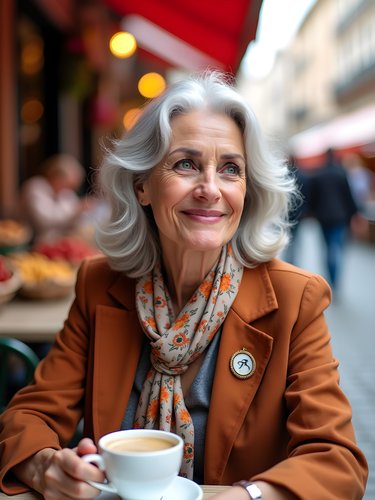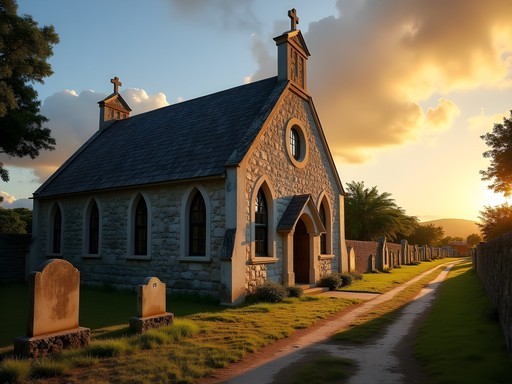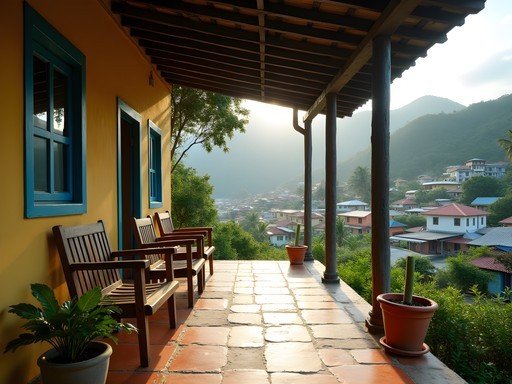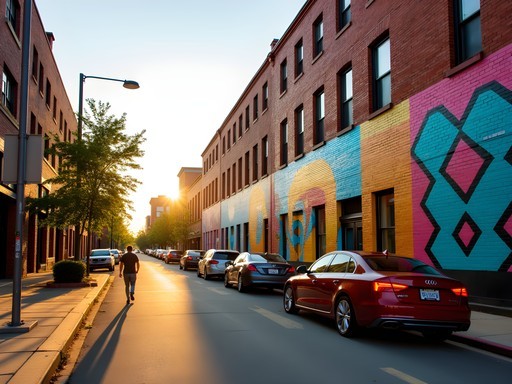Disclosure: This article contains affiliate links. We may earn a commission from purchases at no extra cost to you, which helps our travel content.
There's a particular quality to the light in Liberta that I've not encountered elsewhere in my travels—a golden warmth that bathes the weathered limestone buildings in the late afternoon, transforming humble structures into architectural treasures worthy of documentation. While most visitors to Antigua and Barbuda make a beeline for the island's famed 365 beaches (one for each day of the year, as locals proudly assert), I found myself drawn inland to this historical settlement, established by freed slaves in 1835. What began as a quick weekend diversion from my legal conference in St. John's evolved into a profound exploration of a community whose story is etched into every weathered cornerstone and vibrant mural. For the intrepid solo traveler willing to venture beyond the pristine coastline, Liberta offers an unfiltered glimpse into Antiguan life—where the island's complex history converges with its dynamic present in a tapestry of sound, color, and unforgettable human connection.
Historical Footprints: Liberta's Architectural Narrative
The genesis of Liberta as one of the Caribbean's first free Black settlements following emancipation is evident in its architectural composition—a fascinating juxtaposition of colonial influence and African-derived sensibilities. The settlement pattern itself tells a story; unlike the rigid grid layouts of colonial towns, Liberta evolved organically along footpaths and natural contours of the land.
The St. Barnabas Anglican Church stands as the community's architectural centerpiece, its weathered stone facade bearing silent witness to nearly two centuries of island history. What captivated me most was not the structure itself—though its modest Gothic Revival elements are certainly noteworthy—but rather the surrounding cemetery, where headstones dating to the 1830s chronicle the community's founding families.
Wandering the narrow lanes radiating outward from the church, I documented numerous vernacular dwellings that blend British colonial templates with distinctly Caribbean adaptations. The 'chattel house' tradition is particularly evident here—modest wooden homes built on stone foundations without being permanently affixed, a direct response to historical land tenure uncertainties faced by formerly enslaved people. Many feature intricate fretwork along verandas and eaves, what architectural historians term 'gingerbread trim,' executed with remarkable precision despite limited tools.
For those interested in architectural documentation, I found my compact tripod invaluable for capturing the detailed craftsmanship in low-light situations, particularly inside older structures where permission was granted.

💡 Pro Tips
- Visit St. Barnabas Church on weekday mornings when the caretaker is often available to share historical context
- Bring small denominations of Eastern Caribbean dollars as donations for community buildings you photograph
- Ask permission before photographing occupied homes—a respectful approach yields not only consent but often fascinating stories
The Market Pulse: Saturday Morning Rituals
If architectural exploration provides the historical framework of Liberta, then the Saturday morning market supplies its contemporary heartbeat. Arriving just after 7 AM—a compromise between my body's resistance to holiday early-rising and the locals' advice to 'come before the good produce disappears'—I found the small market square already pulsating with activity.
Unlike the more tourist-oriented markets in St. John's, Liberta's market exists primarily for local commerce. Farmers from surrounding hillsides arrange their offerings on makeshift tables: pyramids of mangoes and soursops, bundles of root vegetables still carrying traces of the volcanic soil in which they were grown, and an astonishing variety of herbs I recognized from my mother's garden in Galway, though bearing entirely different local names here.
The market's sensory dimensions extend well beyond the visual. The air is perfumed with the competing aromas of street food—particularly noteworthy are the 'ducana' (sweet potato dumplings wrapped in banana leaves) and salt fish, a combination that constitutes something of a national dish. The percussion of Antiguan dialect creates a linguistic soundscape as vendors and customers engage in negotiations that seem as much social ritual as commercial transaction.
I spent three hours documenting the market's ephemeral architecture—the ingenious ways vendors create shade structures and display systems from minimal materials—while gradually being drawn into conversations. My compact camera proved ideal for this environment, allowing unobtrusive photography while being robust enough to withstand the tropical humidity.

💡 Pro Tips
- Bring a reusable shopping bag—plastic bags are increasingly discouraged throughout Antigua
- Try the local bush tea, typically a blend of lemongrass, mint and other herbs with purported medicinal properties
- Ask vendors about unfamiliar produce—they're typically delighted to explain preparation methods
Artistic Expressions: Community Murals and Craftwork
One aspect of Liberta that particularly resonated with my interest in urban documentation was the prevalence of community art—not installed as tourist attractions but emerging organically as expressions of local identity. The most striking examples are the murals adorning the community center walls, executed primarily by youth groups under the guidance of elder artists.
These murals function as visual archives of Liberta's historical consciousness, depicting scenes from emancipation, agricultural traditions, and cultural celebrations. The stylistic approach blends Caribbean folk art sensibilities with contemporary techniques, creating a visual language that feels both rooted in tradition and dynamically present.
Beyond public murals, Liberta sustains several cottage industries centered on traditional crafts. I spent a fascinating afternoon with Ms. Eloise, a septuagenarian basket weaver whose fingers moved with hypnotic dexterity as she transformed palm fronds into intricate vessels. The techniques she employs, she explained, derive from West African traditions preserved through generations of knowledge transmission.
'My grandmother's hands taught my hands,' she told me, 'and now I teach the young ones, though they have less patience these days.'
Similarly, the pottery collective operating from a modest workshop near the village outskirts produces pieces that reference both Amerindian ceramics (the island's pre-Columbian inhabitants) and African-derived forms. What struck me was how these artisans work without romanticizing their output as 'cultural preservation'—this is living craft evolving through active practice.
For documenting these visits, I found my audio recorder indispensable for capturing the craftspeople's explanations of their techniques and the stories they shared while working.

💡 Pro Tips
- The pottery collective welcomes visitors on Wednesday and Friday afternoons, with opportunities to purchase directly from artisans
- Ask permission before photographing individual craftspeople or their works-in-progress
- Small monetary contributions toward youth art programs are appreciated when photographing community murals
Culinary Geography: Mapping Liberta Through Food
My legal career has taught me that understanding any community requires attention to its fundamental systems—and few systems reveal more than food pathways. In Liberta, I mapped the community through its culinary geography, moving beyond the simplistic notion of 'local cuisine' to document how food production, preparation, and consumption patterns illuminate social structures.
The day begins at Mama J's, an establishment defying easy categorization—part bakery, part breakfast spot, part community message board. By 6:30 AM, workers from surrounding areas queue for her justifiably renowned salt fish bakes, consumed standing at roadside counters before departing for construction sites and hotels along the coast. The gender dynamics are immediately apparent: morning food spaces predominantly accommodate male workers, while women operate the establishments.
By midday, the culinary geography shifts. Small home-based operations—often indicated by nothing more than a handwritten sign or colored flag—offer lunch from front verandas. These micro-restaurants typically feature one daily option: perhaps pepperpot stew or rice with locally-caught fish. The economic ingenuity impressed me; women transform domestic spaces into commercial enterprises with minimal investment, creating sustainable livelihoods while maintaining household responsibilities.
Evening brings another transition as rum shops—predominantly male spaces during weekdays—become more communal on weekends. At Mackenzie's Corner Shop, I observed the intricate social choreography as dominoes games unfolded alongside heated political debates and family announcements, all lubricated by Antigua's Cavalier rum and accompanied by increasingly elaborate snacks prepared in the adjacent kitchen.
For navigating between these culinary landmarks, I relied heavily on my water filtration bottle, which allowed me to refill safely throughout the day while reducing plastic waste.

💡 Pro Tips
- Most home-based food operations accept only cash, so carry sufficient Eastern Caribbean dollars
- Ask locals about 'special foods' served only on specific days—many traditional dishes appear only on weekends
- When invited to someone's home for a meal, bringing a small gift (perhaps fruit or wine) is appreciated though not expected
Sacred Spaces: Sunday Morning Observations
Though my professional background inclines me toward methodical documentation rather than participation in religious practices, I found Liberta's Sunday morning landscape irresistible as an ethnographic study. The community hosts four churches within walking distance—Anglican, Methodist, Seventh-Day Adventist, and a Pentecostal assembly—creating a fascinating tableau of denominational variation within a small geographic footprint.
The auditory dimensions proved most striking. Standing at the village crossroads at 10:30 AM, I could simultaneously perceive Anglican hymns, Methodist responsive readings, and the exuberant percussion-backed gospel emanating from the Pentecostal gathering. This created what musicologists might term 'sacred soundscapes'—overlapping sonic territories demarcating spiritual boundaries more effectively than physical architecture.
The visual elements were equally compelling. Church attire in Liberta constitutes nothing short of sartorial theater, particularly among women of certain age cohorts. Elaborate hats—architectural achievements in their own right—coordinate with meticulously tailored ensembles in vibrant chromatic schemes. These Sunday presentations reflect both West African aesthetic traditions and British colonial influences, synthesized into a distinctly Antiguan visual language.
What fascinated me most, however, was the post-service social geography. After formal worship, congregants engaged in extended conversations at church perimeters, creating concentric rings of social interaction that appeared to follow unspoken but clearly understood protocols regarding age, gender, and community status. These conversations frequently continued at Sunday lunch gatherings in private homes, to which I was graciously invited on my second weekend.
For documenting these observations discreetly, I found my pocket notebook preferable to digital devices, which might have appeared intrusive in these sacred contexts.

💡 Pro Tips
- If attending services as an observer, dress modestly and respectfully—covered shoulders for women and long trousers for men
- Photography during actual services is generally inappropriate unless specifically invited
- Visitors are typically welcomed warmly but should follow locals' lead regarding participation in unfamiliar rituals
Final Thoughts
As my weekend exploration of Liberta extended into nearly a fortnight, I found myself reluctant to return to the coastal resorts that dominate Antigua's tourism narrative. There's an authenticity to this community that defies commodification—a quality increasingly rare in our era of curated experiences. What began as an architectural documentation project evolved into something far richer: an appreciation for how community life in Liberta represents a continuous negotiation between historical memory and contemporary reality. For the solo traveler willing to set aside itineraries and embrace serendipitous encounters, Liberta offers something beyond typical Caribbean experiences—a genuine immersion into island life as lived rather than performed for visitors. I departed with notebooks filled, camera memory cards exhausted, and a profound appreciation for a community that welcomed my curious gaze with remarkable generosity. Perhaps the true measure of meaningful travel isn't the landscapes we document but the human connections we forge along the way.
✨ Key Takeaways
- Liberta offers authentic community engagement beyond Antigua's resort-dominated tourism
- The settlement's history as one of the Caribbean's first free Black communities following emancipation is reflected in its architecture and cultural practices
- Small-scale, informal economies (home restaurants, craft production, market vendors) reveal ingenious adaptations to economic challenges
- Respectful engagement with local residents yields far richer experiences than passive observation
📋 Practical Information
Best Time to Visit
year-round, though December-April offers most reliable weather
Budget Estimate
$50-75/day excluding accommodation
Recommended Duration
2-3 days minimum
Difficulty Level
Intermediate
















Comments
sunnylife
That shot of the elderly craftsman with his grandchildren is everything! Really captures the generational connection you mentioned.
Hunter Thompson
Grace, absolutely LOVED this post! Your section on Culinary Geography was spot on! For anyone heading to Liberta, don't miss the tiny blue door café on Fisherman's Row - it doesn't even have a name, just look for the blue door with seashells around it. The owner, Maria, makes a coconut bread that will change your life! I spent every morning there watching the town wake up. Also, if you walk about 20 minutes east of the marketplace, there's a viewpoint where you can see both the town and the distant coastline - perfect for sunset! The local kids play football there in the evenings and they're always up for visitors joining in. Definitely the highlight of my Antigua trip!
smartwalker
Love how you captured the essence of local life! How safe did you feel walking around? Planning a solo trip there in October.
Hunter Thompson
Not Grace obviously, but I was in Liberta solo back in January and felt completely safe. The locals were incredibly welcoming, just use normal travel common sense. Definitely try the food stalls near the main square around sunset - incredible vibes!
smartwalker
Thanks Hunter! That's really reassuring. Any specific food stall I shouldn't miss?
Sage Dixon
Grace, your description of that golden light in Liberta took me right back to my visit last spring! I spent three days exploring those limestone streets, and ended up extending my stay just like you did. The Saturday market became my morning ritual too - that elderly woman who sells the spiced mango? Life-changing. Did you make it to the small pottery workshop on the eastern edge of town? The family there has been making ceramics for seven generations, and they let visitors try their hand at the wheel. I captured the whole experience in my travel journal which never leaves my side on these adventures. Your post makes me want to return and discover more of those community murals I missed!
redperson404
Finally! Someone writing about the real Antigua beyond the resort walls. Those community murals sound amazing!
dreamfan
Right? I'm always looking for these hidden gems when I travel. Grace, did you need a guide to find these murals or are they easy to spot?
sunnylife
We stumbled across them just wandering around last year! No guide needed, just walk through the neighborhoods north of the main square.
greenninja
Heading to Antigua in September. How's the weather in Liberta that time of year? Worth the trip from the resort area?
adventurenomad
Definitely worth it! September can be rainy but usually just afternoon showers. Morning is perfect for the market Grace mentioned.
Sophia Gomez
Grace, your description of that golden afternoon light took me right back to my own visit! I stumbled upon Liberta during a business trip to Antigua last year and ended up extending my stay by three days just to explore more. For anyone planning a visit, I highly recommend the small café near the community murals - Maria's Corner. They make this incredible ginger-spiced coffee that I still dream about. Also, if you're into photography, bring a wide-angle lens for those narrow streets with the limestone buildings. I captured some magical moments using my travel tripod during the golden hour Grace describes. The architectural contrasts between colonial and modern elements tell such a fascinating story.
greenninja
Maria's Corner is amazing! Their banana bread is also to die for.
nomadninja5072
Those food pics are making me hungry! Anyone try that seafood place mentioned?
adventurenomad
This is exactly what I needed to read! I've been to Antigua twice but always stayed at the resorts. That market section has me convinced to venture into Liberta next time. Did you find it easy to navigate as a foreigner? I'm always a bit nervous about wandering into more local areas but those community murals sound incredible.
Sophia Gomez
I explored Liberta last year and found it super welcoming! Just bring a decent map or download offline Google Maps, and you'll be fine. The locals were incredibly friendly when I asked for directions.
adventurenomad
Thanks Sophia! That's reassuring. Did you go solo or with a group?
Sophia Gomez
I went solo! Felt completely safe during daytime hours. Just use the same common sense you would in any town.
Sage Dixon
Grace, this resonates so deeply with me! I had a similar experience in Antigua last year where I escaped the resort bubble and found myself in Liberta. That community mural project you mentioned is actually expanding - I spoke with the lead artist Miguel who said they're adding five new walls this summer. The contrast between resort life and actual Antiguan community is striking. I spent an afternoon with an elderly woman named Ms. Josephine who showed me how to make traditional cassava bread - an experience no resort excursion could ever provide. Your post captures exactly why we should all venture beyond the prescribed tourist paths. Beautiful work as always!
Grace Boyd
Sage! So good to see you here. I didn't meet Miguel but heard so much about him. That cassava bread experience sounds incredible - those unplanned connections are always the most meaningful. Let me know next time you're heading somewhere similar!
Venture X
Premium card with 2X miles, $300 travel credit, Priority Pass